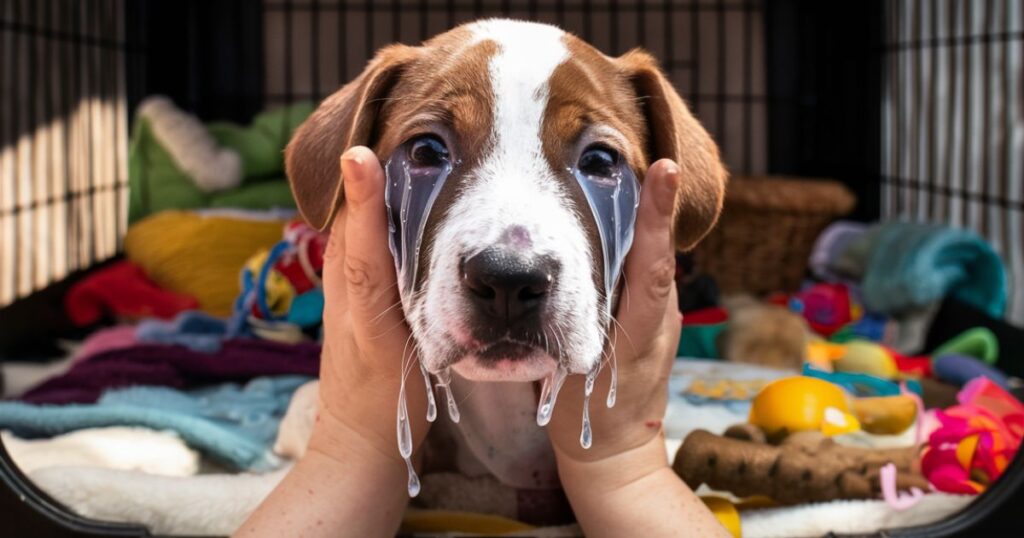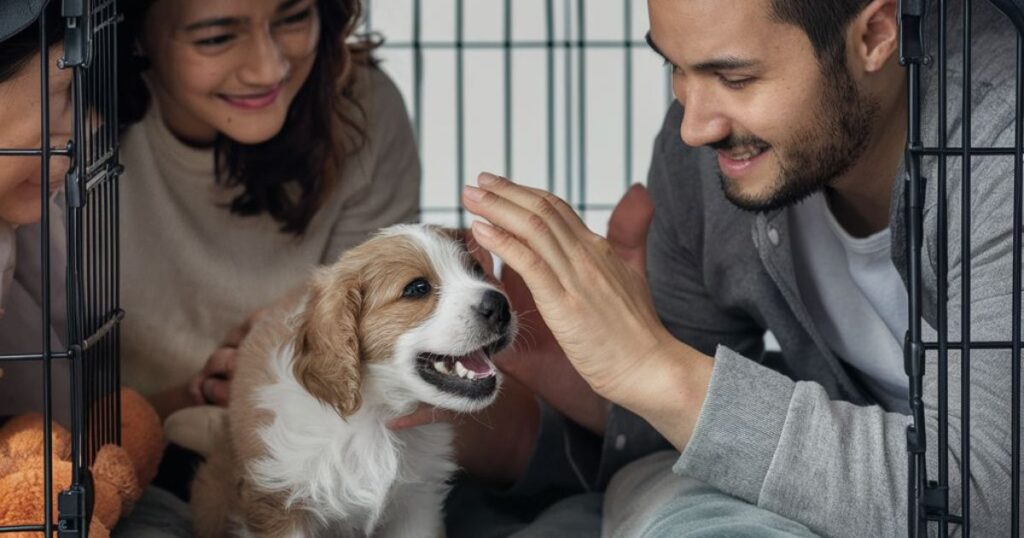Crate training is an essential aspect of nurturing your puppy’s growth. It offers them a secure environment to retreat to, fostering a sense of safety and stability. However, determining the duration for which your puppy should cry in their crate is crucial to strike the right balance between training and empathy.
It’s imperative to approach crate training with patience and gradual progression. Start with short intervals and gradually extend the duration as your puppy becomes more accustomed to the crate.
Comforting your puppy during distress can help ease their anxiety and build trust in their crate as a safe space. Remember, consistency and positive reinforcement are vital in ensuring successful crate training and fostering a strong bond with your furry companion.
Dogs Instinctively Seek Crates
Dogs have a natural instinct to seek out small, enclosed spaces like crates. These spaces provide them with a sense of security and comfort, similar to a den in the wild. It’s a safe haven where they can retreat and relax whenever they feel stressed or overwhelmed.
When properly introduced to a crate, dogs often view it as their personal sanctuary. It becomes a familiar and comforting space where they can rest, sleep, or simply take a break from the hustle and bustle of daily life. Crate training taps into this instinctive behavior, making it easier for dogs to adapt to their new environment and routine.
For many dogs, crates offer a sense of ownership and control over their surroundings. They see it as their own territory, where they can feel safe and in control of their environment. This innate instinct makes crate training a natural and effective way to provide dogs with a secure and comfortable space of their own.
Why is my puppy crying in their crate?
Puppies cry in their crate because they’re adjusting to a new environment. It’s natural for them to feel anxious and seek comfort. Your puppy may also cry if they need to go potty, as they’re still learning bladder control.

Another reason for crying could be loneliness or boredom. Puppies are social animals and may cry when they feel isolated. Providing them with toys and comfort items can help alleviate their distress. Sometimes, puppies cry simply because they miss their littermates or want your attention. To address your puppy’s crying, ensure their crate is comfortable and safe.
Gradually acclimate them to spending time alone in the crate. Offer praise and treats for calm behavior, and never punish them for crying. With patience and consistency, your puppy will learn to feel secure in their crate.
Here Is Blog For You :https://petplacid.com/crate-size-for-goldendoodle-with-expert-recommendations/
Your Puppy Needs To Go Potty
If your puppy is crying in their crate, they might need to go potty urgently. Puppies have smaller bladders and shorter control over their bodily functions, so they can’t hold it for long. When they cry, it’s often a signal that they need to relieve themselves. Taking them outside promptly when you hear this cry helps in reinforcing positive potty training habits and prevents accidents inside the house.
Your Puppy Wants To Be Near You
Your puppy may cry in their crate because they simply want to be near you. Puppies crave companionship and may feel anxious when separated from their human family members. They find comfort in your presence and may cry to express their desire to be close to you. Providing reassurance and spending quality time with your puppy when they’re not in the crate can help alleviate their distress and strengthen your bond.
How to get a puppy to stop whining in their crate?
To stop a puppy from whining in their crate, begin by ensuring their basic needs are met. Make sure they have food, water, and have been taken outside to potty before crating them. A tired puppy is less likely to whine, so engage them in play and exercise before crate time.

Introduce positive associations with the crate to reduce whining. Use treats, toys, and praise to create a pleasant environment inside the crate. Gradually increase crate time, starting with short intervals, and gradually extending them as your puppy becomes more comfortable.
The reinforcing whining behavior by not responding immediately. Wait for a moment of silence before opening the crate, and praise them when they are calm. Consistency is key in teaching your puppy to associate the crate with relaxation and security, ultimately reducing their whining over time.
Ignore The Behavior
Ignoring your puppy’s whining behavior in their crate can be an effective strategy to extinguish it. When you respond to whining with attention or by letting them out of the crate, you inadvertently reinforce the behavior. Instead, wait for a break in the whining before providing any attention or opening the crate.
By consistently ignoring the whining and only rewarding quiet behavior, you can teach your puppy that whining will not result in the desired outcome, ultimately leading to a reduction or cessation of the behavior over time.
How Long Should You Ignore A Puppy Crying In A Crate?
When deciding how long to ignore your puppy’s crying in their crate, it’s essential to balance patience with their well-being. Start by waiting for a brief pause in the crying before providing any attention.
As your puppy becomes accustomed to the crate, gradually extend the duration of ignoring the crying, always ensuring they are safe and comfortable. Remember, consistency is key, and over time, your puppy will learn that quiet behavior is rewarded.
Familiarize Your Puppy With Her New Crate
Introducing your puppy to her new crate is crucial to help her feel comfortable and secure. Start by placing familiar items like toys or blankets inside the crate to make it inviting. Encourage your puppy to explore the crate at her own pace, using treats and praise to create positive associations.
Spend time near the crate with your puppy to help her feel at ease, gradually increasing the duration of time spent inside. With patience and positive reinforcement, your puppy will learn to see her crate as a safe and comforting space.
Tire Out Your Puppy First
Before crating your puppy, it’s beneficial to tire them out with exercise and playtime. Engage in activities that stimulate both their mind and body, such as fetch or a brisk walk.
A tired puppy is more likely to relax and settle down in their crate without as much fuss. By expending their energy beforehand, you can help prevent excessive whining or restlessness inside the crate, making the crating experience more enjoyable for both you and your puppy.
How to Make a Crying Puppy Comfortable in their Crate
To make a crying puppy comfortable in their crate, start by ensuring the crate is cozy and inviting. Add soft bedding and a few familiar toys to create a comforting environment. Avoid placing items that could be a choking hazard or cause discomfort.
The consider placing a piece of clothing with your scent near the crate to provide familiarity and reassurance to your puppy. Your scent can help calm them and make them feel more secure in their crate. Remember to replace the clothing regularly to maintain the scent.
Lastly, consider using calming aids such as calming sprays or pheromone diffusers to help relax your puppy. These products can create a soothing atmosphere in the crate, making it a more comfortable and calming space for your crying puppy.
Rules for Crate Training
When crate training your puppy, it’s essential to establish clear rules to ensure a positive experience for both you and your furry friend. Firstly, make sure to introduce the crate gradually and in a positive manner. Allow your puppy to explore the crate at their own pace, and never force them inside.
Consistency is key in crate training. Stick to a regular schedule for crate time, including meal times and bathroom breaks. This helps your puppy understand when it’s time to relax in the crate and when it’s time to go outside.
The using the crate as a form of punishment. The crate should be a safe and comfortable space for your puppy, not a place of confinement for misbehavior. By following these rules for crate training benefits, you can help your puppy adjust to their crate and foster a positive association with it.
Frequently Asked Questions
How do I introduce my puppy to their crate?
Start by making the crate inviting with bedding and toys. Encourage exploration with treats and praise.
How long can my puppy stay in the crate?
Aim for 1 hour per month of age, up to 8 hours max, with breaks for bathroom, exercise, and play.
Should I leave food and water in the crate?
The Remove food and water a few hours before crating to prevent accidents. Offer outside the crate.
What if my puppy cries in the crate?
Initially ignore to avoid reinforcement. Ensure comfort and gradually increase crate time with positive reinforcement.
Is crate training suitable for all puppies?
While generally beneficial, some puppies may not respond well. Consult a professional if concerns arise.
Conclusion
The crate training can be a valuable tool in fostering a safe and comfortable environment for your puppy. By following the proper guidelines and incorporating positive reinforcement, you can help your puppy acclimate to their crate and develop positive associations with it.
Remember to be patient, consistent, and attentive to your puppy’s needs throughout the crate training process, and you’ll be on your way to a happy and well-adjusted furry companion.

Jackson is a seasoned professional in the field of pets, boasting four years of enriching experience. His expertise spans pet care, training, and health, ensuring insightful and reliable content for pet enthusiasts on our site.







